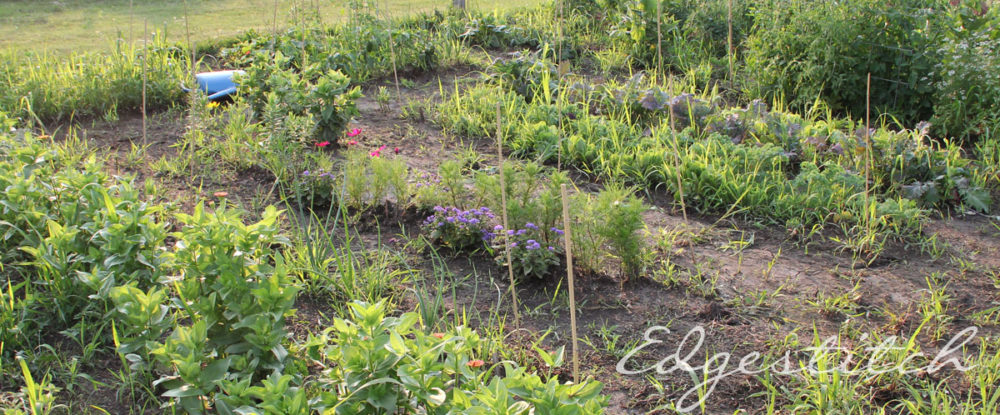When is the last time you thought about where your quilting stash or underwear comes from? Have you ever thought about the process, the transport, the distribution? How many of us have ever even recognized on a conscious level that quilt cotton is a plant?
If these questions seem abstruse or even mildly annoying, you’re not alone. So few people care about this issue. At least that’s the information I was given when I contacted some of the largest distributors of quilting fabric around.
Moda told me there’s no market (that’s us) for organic fabric. Oh yes, they had one line of it a while ago and it didn’t sell terribly well, so…they don’t even carry any organic fabric right now. Fatquartershop.com who sells fabric online said they have nothing to do with the content of their products. In their copy on their website, they describe whatever a manufacturer tells them to say, and distribute on demand. Period.
Fabric designers tell me they do not get involved with the fabric manufacturing process. They license their designs and have no say in whether their designs are used sustainably/responsibly or not. This may not be true for all of them, but it’s common practice.
So who makes the determination about whether fabric should be organic or not?
Surprise! It’s you. And me. We are the ones who define this market, and we will have to be the ones to require change.
The question is: Do you think we need to change?
Let’s talk about it a bit. Because I’m going to make the case that we have no choice but to put pressure on manufacturers to change their cotton growing processes. And we might have to start with our local quilt shops.
Here’s why:
–70% of the world’s topsoil is degraded.
–It takes 1,000 years to replace 3 cm of degraded topsoil.
–With current farming practices, all the world’s topsoil will be gone in 60 years.
This is not my opinion.
This information is provided by lengthy studies done by the Textile Exchange and reported in life cycle analyses done over spans of years.
Go ahead and google “How much topsoil is left?”
Without topsoil, the world doesn’t eat, let alone quilt with natural fabrics.
I don’t know about you, but I don’t want to be responsible for my kids and grandkids being unable to have food and clothing because of my simplistic, uneducated (and, frankly, selfish) choices.
I’ve seen some people make the case that organic fabric requires more resources.
That is simply not true. Not when using any scientific methodology of measurement. Not when attempting to understand the life cycle of the product. And certainly not when we entertain the implications of the alternative. On the contrary, we now have clear indications that water use on organic farms is far less than traditional practices.
Organic farming of cotton greatly reduces water and other energy consumption, and continuing on our current trajectory is simply not sustainable.

Here is where we encounter the power of market forces.
You and I can demand that things change. Manufacturers, distributors and farmers, all have little reason to improve their processes. Inertia and monetary fears will keep them all from advancing to more sustainable processes.
But the science tells us that we will pay a price one way or another. As consumers, we either start demanding organic cotton now, or we will not likely have access to any at all in the future. The choice is that simple and that stark.
But I’m just one person.
What can I do?
-Ask your local quilt shop to carry organic cotton. Be assertive. Those designers that you love? Their designs can be made on organic cotton. But folks like Moda (who is a HUGE distributor of fabric) think you don’t care. I’m telling you it’s time to care and care deeply.
—Contact folks like Moda directly: marketing@modafabrics.com and let them know about your concerns.
–Do your own research. Here are a few links to explore:
—Quick Guide to Organic Cotton
–Get the Facts About Organic Textiles
Hope is on the horizon.
But we must all start to act.
Folks like Wrangler, H & M and Nike are starting to recognize that their own businesses will not be around if they don’t educate consumers on organic products, and make the industry more sustainable.
The organic cotton industry has increased by 11% in the US from 2016 to 2018. But that’s not enough. Where does our quilt cotton come from? India? China? the US?
I don’t have all the answers. But I will continue to follow up. In the meantime, I will continue to work down my stash of fabric, and I plan on only purchasing organic fabric in the future. This is a statement I can only make because I’ve done a bit of homework on this and believe it is the best path for me.
I’ll be exploring more of the current manufacturers soon. The good news is that there ARE organic quilt fabrics out there. We just aren’t aware of them.

I leave you today with a current picture of my own garden out back. Our Midwestern loam is the finest on the planet. Everything grows here. But we need to be responsible stewards of the land, of our money and of our resources.
I’m ready to take the organic leap. Are you?
